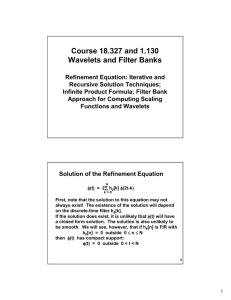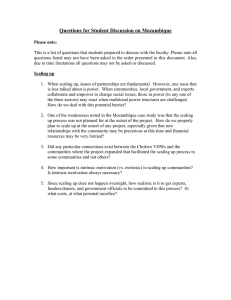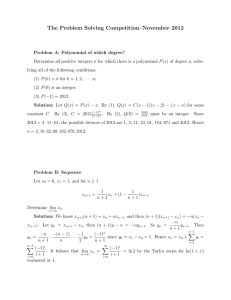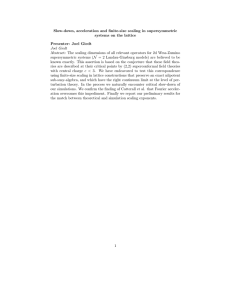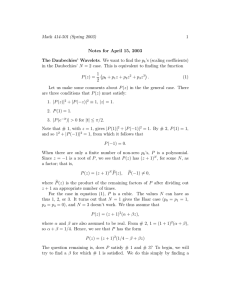Course 18.327 and 1.130 Wavelets and Filter Banks
advertisement
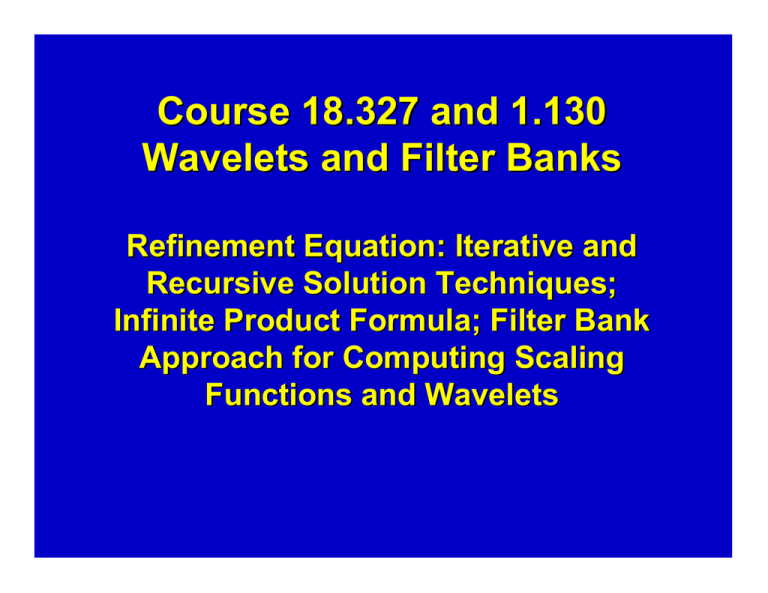
Course 18.327 and 1.130
Wavelets and Filter Banks
Refinement Equation: Iterative and
Recursive Solution Techniques;
Infinite Product Formula; Filter Bank
Approach for Computing Scaling
Functions and Wavelets
Solution of the Refinement Equation
N
φ(t) = 2∑ h0[k] φ(2t-k)
k=0
First, note that the solution to this equation may not
always exist! The existence of the solution will depend
on the discrete-time filter h0[k].
If the solution does exist, it is unlikely that φ(t) will have
a closed form solution. The solution is also unlikely to
be smooth. We will see, however, that if h0[n] is FIR with
h0[n] = 0 outside 0 ≤ n ≤ N
then φ(t) has compact support:
φ(t) = 0 outside 0 < t < N
2
Approach 1 Iterate the box function
φ(0)(t)
φ(i + I) (t)
φ(t)
= box function on [0 , 1]
N
0
1
t
= 2∑ h0[k] φ(i) (2t – k)
k=0
If the iteration converges, the solution will be given
by
lim
φ(i)(t)
i→ ∞
This is known as the cascade algorithm.
3
Example: suppose h0[k] = {¼, ½, ¼}
φ (i+1) (t) = ½ φ(i)(2t) + φ(i) (2t – 1) + ½ φ(i) (2t – 2)
Then
φ(0)(t)
φ(0)(t)
1
1
1
2
0
1
2
φ(2)(t)
t
1
0 2
φ(3)(t)
1
½
1
3
2
2
3
1 2
2
t
1
1
0 2
3
1 2
2
t
1
0 2
Converges to the hat function on [0, 2]
t
4
Approach 2 Use recursion
First solve for the values of φ(t) at integer values of t.
Then solve for φ(t) at half integer values, then at quarter
integer values and so on.
This gives us a set of discrete values of the scaling
function at all dyadic points t = n/2i.
At integer points:
N
φ(n) = 2 ∑ h0[k] φ (2n – k)
k=0
5
Suppose N = 3
3
φ(0) = 2 ∑ h0[k] φ(-k)
k=0
3
φ(1) = 2 ∑ h0[k] φ(2-k)
k=0
3
φ(2) = 2 ∑ h0[k] φ(4-k)
k=0
3
φ(3) = 2 ∑ h0[k] φ(6-k)
k=0
Using the fact that φ(n) = 0 for n < 0 and n > N, we
can write this in matrix form as
φ(0)
h0[0]
φ(0)
φ(1)
h0[2] h0[1] h0[0]
φ(1)
= 2
φ(2)
h0[3] h0[2] h0[1]
φ(2)
φ(3)
h0[3]
φ(3)
6
Notice that this is an eigenvalue problem
λΦ = AΦ
where the eigenvector is the vector of scaling function
values at integer points and the eigenvalue is λ = 1.
Note about normalization:
Since (A - λI) Φ = 0 has a non-unique solution,
we must choose an appropriate normalization for Φ
The correct normalization is
∑ φ(n) = 1
n
This comes from the fact that we need to satisfy the
partition of unity condition, ∑ φ(x-n) = 1.
n
7
At half integer points:
N
φ (n/2) = 2 ∑ h0[k] φ (n-k)
k=0
So, for N = 3, we have
φ(1/2)
φ(3/2)
φ(5/2)
=
h0[1] h0[0]
2 h0[3] h0[2] h0[1] h0[0]
h0[3] h0[2]
φ(0)
φ(1)
φ(2)
φ(3)
8
Scaling Relation and Wavelet Equation
in Frequency Domain
φ(t) = 2 ∑ h0[k] φ(2t – k)
k
∞
∫− ∞φ(t)e-iΩt dt
∞
= 2 ∑ h0[k]
k
φ(2t – k) e-iΩt dt
∫
−∞ ∞
= 2 ∑ h0[k] ½
k
=
∞
–iΩ(τ + k)/2 dτ
φ
(
τ
)e
∫
−∞
∞
∑ h0[k]e-iΩk/2 φ(τ)
k
−∞
∫
e- iΩτ/2 dτ
9
^
i.e. φ(Ω) = H0(Ω2 ) .
^( Ω )
φ 2
= H0(Ω2 ) . H0 (Ω4 ) . ^
φ (Ω4)
^
φ(0) =
Π
j=1
Ω
H0( 2j )
QU`
=
LMN
∞
o
^
φ (0)
∞
∫− ∞ φ(t) dt
= 1 (Area is normalized to 1)
10
So
∞
^
φ(Ω) = Π H0 (Ωj )
j=1
2
Infinite Product Formula
Similarly
w(t) = 2 ∑ h1[k] φ(2t – k)
k
leads to
^ Ω) = H ( Ω ) ^φ
w(
1 2
( Ω2 )
Desirable properties for H0(ω):
• H(0) = 1, so that ^
φ(0) = 1
• H(ω) should decay to zero as ω → π ,
∞
so that
^(Ω)2d Ω < ∞
φ
∫
−∞
11
Computation of the Scaling Function and
Wavelet – Filter Bank Approach
y0[n] ↑2
H0(ω) ⊕yY [n]
(ω) ↑2
x0[n] ↑2
H1(ω)
1
1
↑2
x1[n]
H0(ω) ⊕Yy [n]
(ω) ↑2
y2[n]
2
H0(ω)
⊕
y3[n]
Y3(ω)
H1(ω)
↑2
x2[n]
H1(ω)
Normalize so that ∑ h0[n] = 1.
n
12
i. Suppose y0[n] = δ[n] and xk[n] = 0.
Y0(ω) = 1
Y1(ω) = Y0(2ω) H0(ω) = H0(ω)
Y2(ω) = Y1(2ω) H0(ω) = H0(2ω)H0(ω)
Y3(ω) = Y2(2ω) H0(ω) = H0(4ω) H0(2ω) H0(ω)
After K iterations:
K-1
YK(ω) = Π H0(2kω)
k=0
What happens to the sampling period?
Sampling period at input = T0 = 1 (say)
Sampling period at output = TK = ½K
13
Treat the output as samples of a continuous time
signal, yc (t), with sampling period ½K:
K
yK[n] = 12K yc(n/2K)
K
^
⇒YK(ω) = YcK (2Kω) ; -π ≤ ω ≤ π
(yKc (t) is chosen to be bandlimited)
Replace 2Kω with Ω:
K
K-1
^c
YK(Ω) = YK(Ω/2k ) = Π H0(Ω/2K-k ) = Π H0( Ω/2j ) ;
k=0
j=1
j=1
-2Kπ ≤ Ω ≤ 2Kπ
So
∞
^c
^
lim YK(Ω) = Π H0( Ω/2j) = φ(Ω)
k→∞
j=1
14
⇒ 2K yK[n] converges to the samples of the scaling
function, φ(t), taken at t = n/2K.
ii. Suppose y0[n] = 0, x0[n] = δ[n] and all other xk[n] = 0
K-2
YK(ω) = H1(2K-1ω) Π H0(2kω)
k=0
Then
K-2
^c
Ω
K
YK(Ω) = YK(Ω/2 ) = H1( 2 ) Π H0(Ω/2K-k)
=
So
k=0
K-1
Ω
H1( 2 ) Π H0( 12 . Ω
2j
j=1
)
^
^ Ω)
lim YKc(Ω) = H1(Ω/2) φ^ (Ω/2) = w(
K→∞
⇒ 2KyK[n] converges to the samples of the wavelet,
w(t), taken at t = n/2K.
15
Support of the Scaling Function
yk-1[n]
↑2
v[n]
h0[n]
yk[n]
length {v[n]} = 2 • length {yk-1[n]} - 1
Suppose that
h0[n] = 0 for n < 0 and n > N
⇒length {yk[n]} = length {v[n]} + length {h0[n]} – 1
= 2 • length {yK-1[n]} + N – 1
Solve the recursion with length {y0[n]} = 1
So
length {yk[n]} = (2K –1)N + 1
16
i.e. length {yKc(t)} = TK . length {yK[n]}
=
(2K – 1) N + 1
2K
= N-
φ(t)
N-1
2K
lim K → ∞
length {φ(t)} = N
0
N
t
So the scaling function is supported on the interval [0, N]
17
18
Matlab Example 6
Generation of orthogonal scaling
functions and wavelets
MATLAB M-file MATLAB M-file
By Inverse DWT
20
By Recursion
21
Comparison
22
Matlab Example 7
Generation of biorthogonal scaling
functions and wavelets.
MATLAB M-file
Primary Daub 9/7 Pair
24
Dual Daub 9/7 Pair
25
